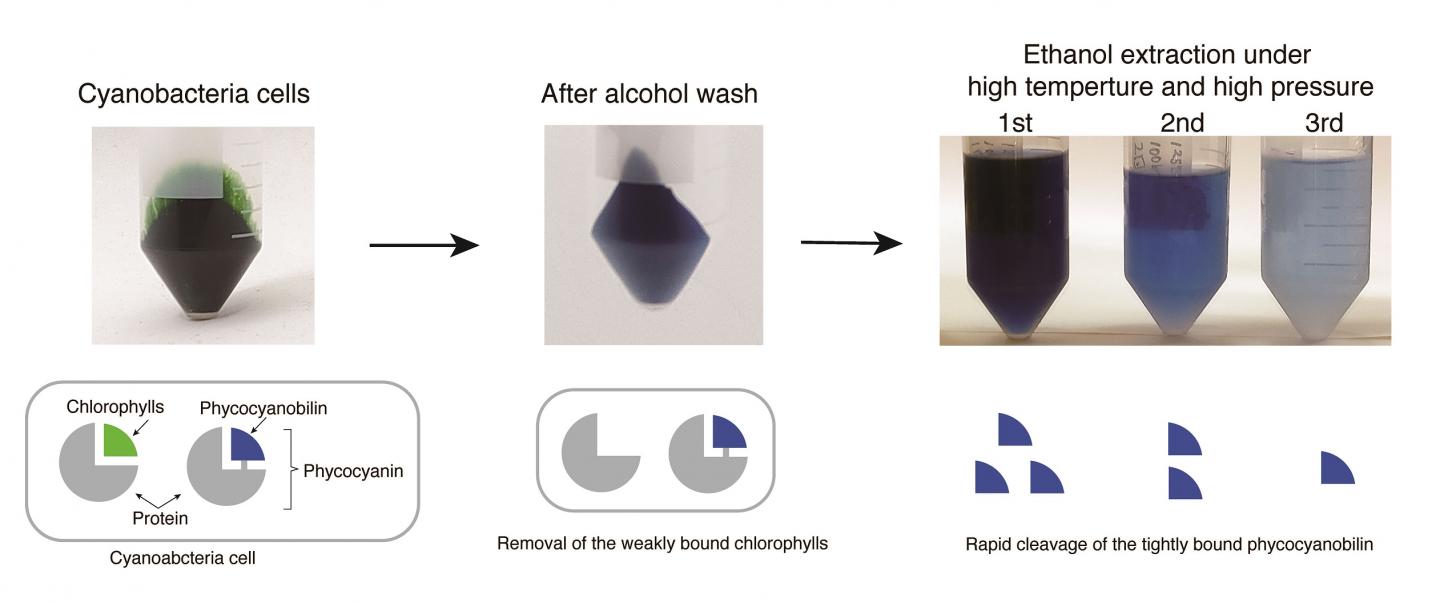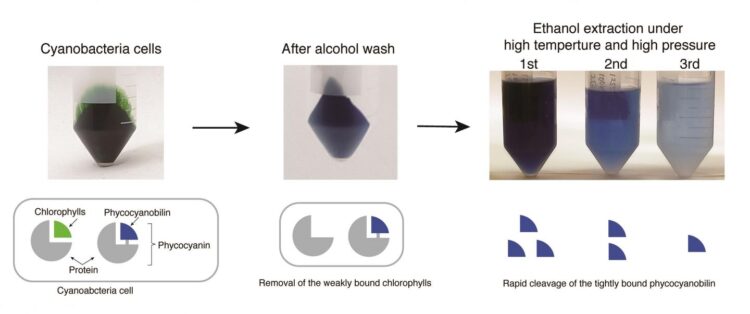
Credit: COPYRIGHT (C) TOYOHASHI UNIVERSITY OF TECHNOLOGY. ALL RIGHTS RESERVED.
Overview:
Phycocyanobilin (PCB) is a natural blue chromophore found in cyanobacteria. PCB is expected to be applied as food colorants and pharmaceuticals with anti-inflammatory and antioxidant properties. PCB also functions as the chromophore of photoswitches that control biological functions in synthetic biology. PCB is covalently bound to phycocyanin, a component of photosynthetic antenna protein, and its extraction requires specialized expertise, time-consuming procedures, and/or expensive reagents. A research group led by Assistant Professor Yuu Hirose at Toyohashi University of Technology succeeded in developing a highly efficient and rapid extraction method for PCB by treating cyanobacterial cells with alcohol under high-temperature and high-pressure conditions. They also demonstrated that this method can be applied to the isotopic labeling of PCB and its reconstitution with photoswitch protein. This technique is expected to lead to the development of new functional foods and medicines and the structural elucidation of various PCB-binding photoswitches.
Details:
Cyanobacteria are prokaryotes that perform oxygen-evolving photosynthesis and utilize phycobilisomes as light-harvesting antenna complexes for photosynthesis. Phycocyanin is a pigment protein that constitutes phycobilisome and has been used as a natural blue colorant in foods such as ice cream. Phycocyanin consists of a blue PCB chromophore and a colorless protein matrix that covalently bounds PCB. The protein matrix of phycocyanin is easily denatured under acidic and high-temperature conditions, which limits the application of phycocyanin as a food colorant. However, PCB is resistant to high temperature and acidic conditions and has the potential to complement the limitations of phycocyanin. However, conventional methods for the extraction of PCB from phycocyanin require a time-consuming purification step for phycocyanin and/or inefficient chemical reaction over 10 h for the cleavage of PCB.
A group comprising Takanari Kamo, Toshihiko Eki, and Yuu Hirose at the Department of Applied Chemistry and Biotechnology, Toyohashi University of Technology, established a simple and rapid method for extracting PCB from cyanobacterial cells. In the method, cyanobacterial cells were washed with alcohol at ambient temperature and atmospheric pressure to remove non-covalently bound chromophores, such as chlorophyll (Fig. 1). PCB was then separated from the protein matrix and extracted in ethanol via three 5-minute treatments under high temperature (125°C) and high pressure (100 bar) conditions (Fig. 1). The extraction efficiency of PCB is comparable to that of conventional methods. The extracted PCB can be used as a food colorant because it uses ethanol as the extraction solvent.
It has been reported in animal experiments that PCB has pharmacological effects, such as anti-inflammatory and anti-oxidant effects. It is expected to be consumed by humans as powder of dried cyanobacteria cells or purified phycocyanin through oral intake. The extraction of PCB would enable a 143- and 25-fold enrichment of PCB concentration in relation to the dried cell powder and purified phycocyanin, respectively, and could facilitate consumption by humans. Therefore, the use of this technology is expected to lead to the development of foods and pharmaceuticals containing higher concentrations of PCB.
PCB is also important in synthetic biology because it functions as a chromophore for photoswitch proteins that control biological functions. In this study, we demonstrated that PCB labeled with isotopic elements (13C and 15N) can be extracted from cyanobacteria cells grown in an isotopic medium. Isotopically labeled PCBs are useful in investigating the detailed structure of the photoswitch by vibrational spectroscopy and nuclear magnetic resonance spectroscopy. We also confirmed that the extracted PCB was incorporated into the photoswitch protein, sensing green and red light, and showing normal spectral sensitivities. Therefore, our technique will contribute to the elucidation of the structure of various PCB-binding photoswitches and the modification of their performance.
###
Future Outlook:
In the future, we expect to develop new blue colorants, functional foods, and pharmaceuticals using PCB. It is also important to elucidate the detailed structure of photoswitches using isotopically labeled PCB and to modify their performance.
Reference:
Pressurized liquid extraction of a phycocyanobilin chromophore and its reconstitution with a cyanobacteriochrome photosensor for efficient isotopic labeling.
Takanari Kamo, Toshihiko Eki, and Yuu Hirose
Plant and Cell Physiology, 2021 in press.
https:/
This research was supported by a Grant-in-Aid for Scientific Research (C) (grant number 19K06707) to Y.H. from the Japan Society for the Promotion of Science (JSPS) and by research grants to Y.H. from the Foundation for the promotion of Ion Engineering and Engineering and JGC-S Scholarship Foundation.
Media Contact
Yuko Ito
[email protected]
Related Journal Article
http://dx.





